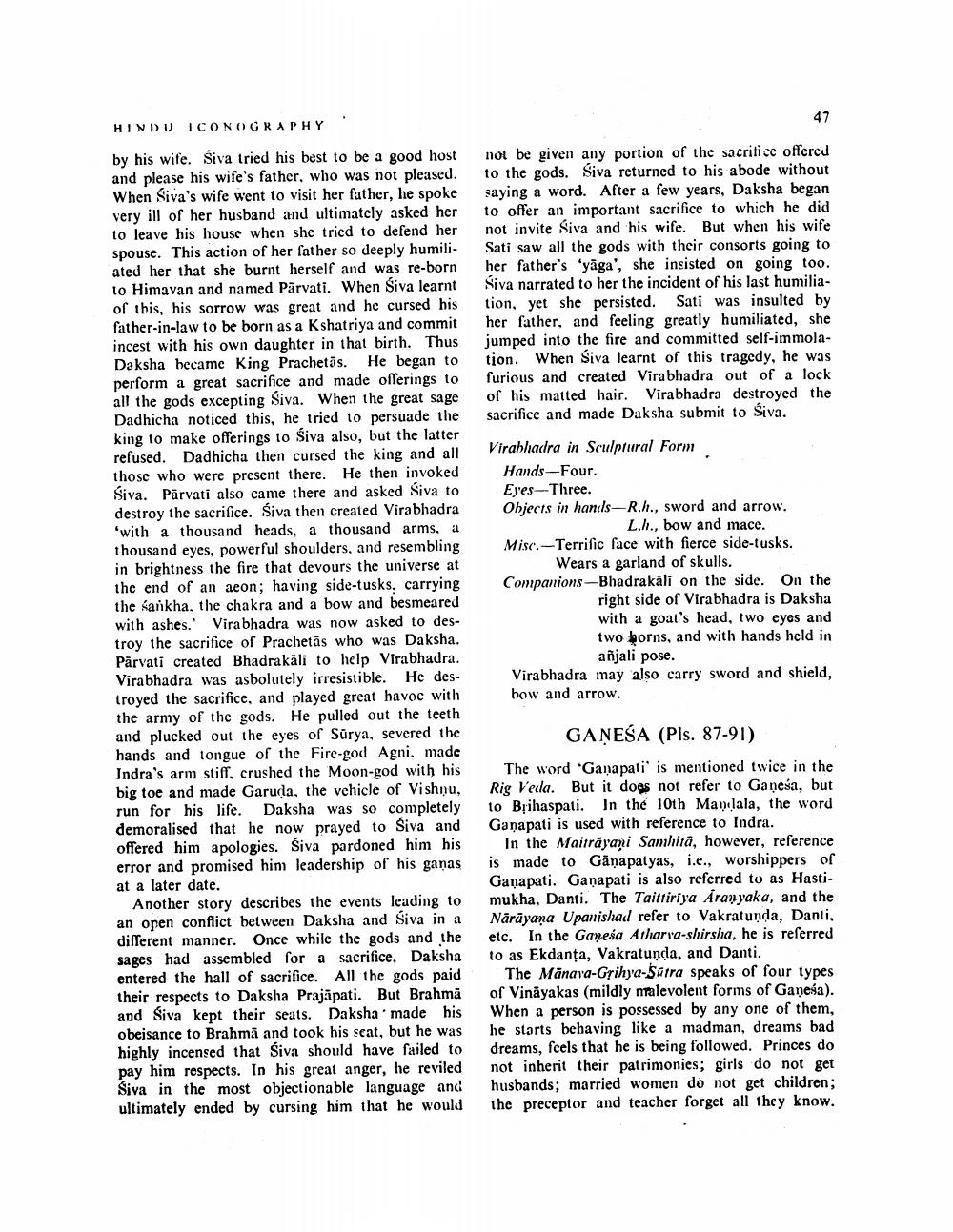________________
HINDU ICONOGRAPHY
not be given any portion of the sacrilice offered to the gods. Siva returned to his abode without saying a word. After a few years, Daksha began to offer an important sacrifice to which he did not invite Siva and his wife. But when his wife Sati saw all the gods with their consorts going to her father's 'yāga', she insisted on going too. Siva narrated to her the incident of his last humiliation, yet she persisted. Sati was insulted by her father, and feeling greatly humiliated, she jumped into the fire and committed self-immolation. When Siva learnt of this tragedy, he was furious and created Virabhadra out of a lock of his matted hair. Virabhadra destroyed the sacrifice and made Daksha submit to Siva.
by his wife. Siva tried his best to be a good host and please his wife's father, who was not pleased When Siva's wife went to visit her father, he spoke very ill of her husband and ultimately asked her to leave his house when she tried to defend her spouse. This action of her father so deeply humili ated her that she burnt herself and was re-born to Himavan and named Pārvati. When Siva learnt of this, his sorrow was great and he cursed his father-in-law to be born as a Kshatriya and commit incest with his own daughter in that birth. Thus Daksha became King Prachetās. He began to perform a great sacrifice and made offerings to all the gods excepting Siva. When the great sage Dadhicha noticed this, he tried to persuade the king to make offerings to Śiva also, but the latter refused. Dadhicha then cursed the king and all those who were present there. He then invoked Siva. Pārvati also came there and asked Siva to destroy the sacrifice. Śiva then created Virabhadra with a thousand heads, a thousand arms, a thousand eyes, powerful shoulders, and resembling in brightness the fire that devours the universe at the end of an aeon; having side-tusks, carrying the Kankha, the chakra and a bow and besmeared with ashes.' Virabhadra was now asked to destroy the sacrifice of Prachetās who was Daksha. Pārvati created Bhadrakāli to help Virabhadra. Virabhadra was asbolutely irresistible. He destroyed the sacrifice, and played great havoc with the army of the gods. He pulled out the teeth and plucked out the eyes of Surya, severed the hands and tongue of the Fire-god Agni, made Indra's arm stiff, crushed the Moon-god with his big toe and made Garuda, the vehicle of Vishnu, run for his life. Daksha was so completely demoralised that he now prayed to Siva and offered him apologies. Siva pardoned him his error and promised him leadership of his ganas at a later date.
Another story describes the events leading to an open conflict between Daksha and Siva in a different manner. Once while the gods and the sages had assembled for a sacrifice, Daksha entered the hall of sacrifice. All the gods paid their respects to Daksha Prajāpati. But Brahma and Siva kept their seats. Daksha' made his obeisance to Brahma and took his seat, but he was highly incensed that Siva should have failed to pay him respects. In his great anger, he reviled Siva in the most objectionable language and ultimately ended by cursing him that he would
Virabhadra in Sculptural Form Hands-Four. Eyes-Three. Objects in hands-R.h., sword and arrow.
L.h., bow and mace. Misc.-Terrific face with fierce side-tusks.
Wears a garland of skulls. Companions -Bhadrakäli on the side. On the
right side of Virabhadra is Daksha with a goat's head, two eyes and two borns, and with hands held in
anjali pose. Virabhadra may also carry sword and shield, how and arrow.
GANESA (Pls. 87-91)
The word 'Ganapati is mentioned twice in the Rig Veda. But it does not refer to Ganesa, but to Brihaspati. In the 10th Manilala, the word Ganapati is used with reference to Indra.
in the Maitrāyani Samhita, however, reference is made to Gānapatyas, i.e., worshippers of Ganapati. Ganapati is also referred to as Hastimukha, Danti. The Taittiriya Aranyaka, and the Nārāyaṇa Upanishad refer to Vakratunda, Danti, etc. In the Ganesa Atharva-shirsha, he is referred to as Ekdanța, Vakratunda, and Danti.
The Mänava-Grihya-Sutra speaks of four types of Vinayakas (mildly nalevolent forms of Ganesa). When a person is possessed by any one of them, he starts behaving like a madman, dreams bad dreams, feels that he is being followed. Princes do not inherit their patrimonies; girls do not get husbands; married women do not get children; the preceptor and teacher forget all they know.




